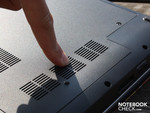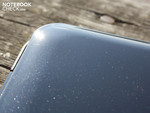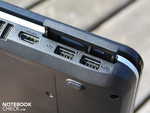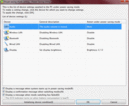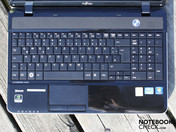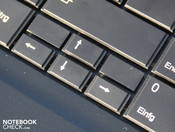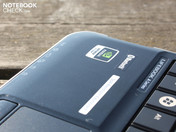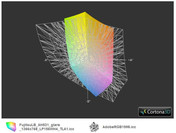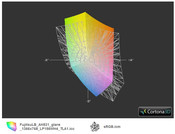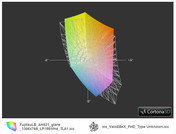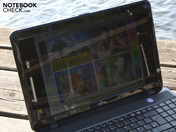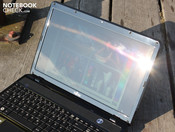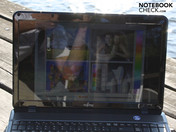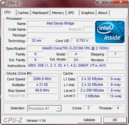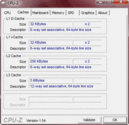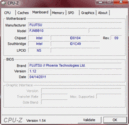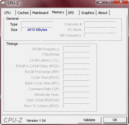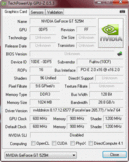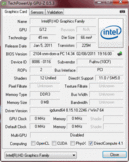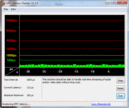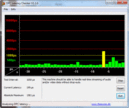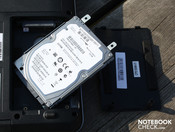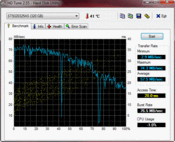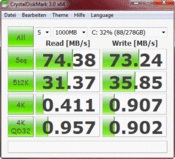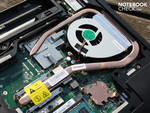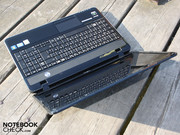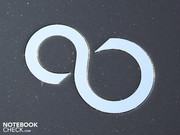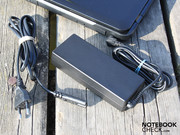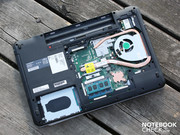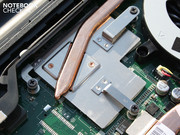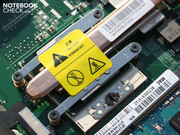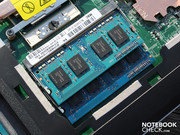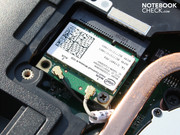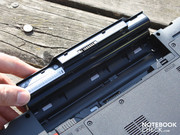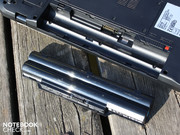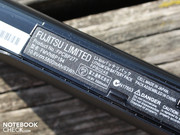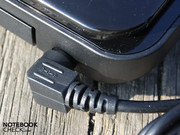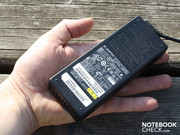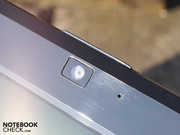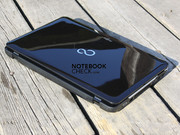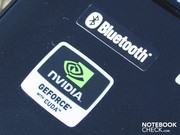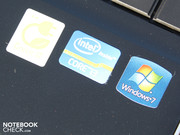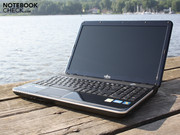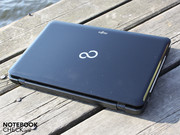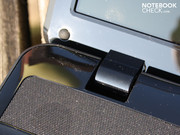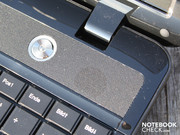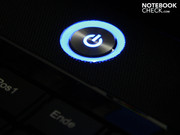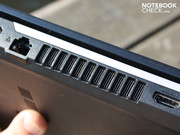Review Fujitsu Lifebook AH531 Notebook

"Unlimited graphics performance" – is how Fujitsu heralds the Lifebook AH531/GFO in its spec sheet. Hopefully no one will believe that because we are talking about an Nvidia GeForce GT 525M (1024MB). In its enthusiastic description, the manufacturer has overlooked the fact that at least knowledgeable customers will sooner smirk at this graphics card than take it seriously.
However, it's the price that is important in the end. And the smallest midrange graphics from Nvidia is positioned at an attractive 549 euros in the Fujitsu Lifebook AH531. That is attention-grabbing because this price design is currently the lowest for a notebook with this graphics card.
We still have to clarify if Fujitsu has successfully built a quality notebook for a small price. What's the keyboard's typing feel like? We'll shed light on these and more questions in this review.
Case
The Fujitsu Lifebook AH 531's case doesn't rely on optical attractions, but does use the moody impression of black piano lacquer with a metallic effect. It's pretty to look at, at first but fingerprints will be the Lifebook user's constant companion. The manufacturer is stingy and doesn't even add an according polishing cloth in the box.
If you now expect a creaky plastic case with a wobbly lid, you'll find yourself wrong. Quite contrarily, the case is rigid, the hinges are tight and the lid is sufficiently stable. The wrist-rest is firm and the key field doesn't yield anywhere. We can only dent the lid in the center. The maximum opening angle of about 145 degrees is more than sufficient for use on the lap. The lid is kept firmly in position by very tightly pulled hinges. There is no teetering. The hinges make a stable and long-lasting impression and fit very tight on the case.
The base plate proves to be made of simple plastic, but it can only be dented slightly at the vents with a finger. The bottom's openings provide the option of exchanging hard disk, RAM (2x2GB) or WLAN module. This also applies to the processor. The Intel Core i3-2310M is inserted and freely accessible.
Connectivity
The interfaces are concentrated on the left, where the vent is also located. A highlight is the ExpressCard54 slot for expansion cards on the left. It allows retrofitting additional interfaces, e.g. USB 3.0 or FireWire. The according cards can be purchased in stores. ExpressCard34 cards also fit in the slot.
There aren't any interfaces on the rear. This is regrettable for use on the desk because all cables gather on the visible sides. Especially the unwieldy HDMI cable or the USB ports placed in the front area could obstruct placing a mouse there.
Communication
In addition to WLAN draft n (Intel 1030), there is Bluetooth 2.1 as wireless technologies in the Lifebook. The Realtek Gigabit Ethernet controller is also up to date.
Supplies
Recovery DVDs are included for Windows 7 Home Premium (64 bit). Fujitsu holds back on bloatware. The few tools are very reasonable: DeskUpdate (downloads updates), Nero9 (burn) and PowerSaving Utility (settings ECO button).
Warranty
The manufacturer's warranty is only for a period of 12 months (bring in). This is valid for purchases made in Germany but can be 24 months in other countries (collect & return service). The manufacturer bids a 3 year collect & return service for a price of 40 euros.
Input Devices
Keyboard
The 15.6 incher's keyboard can be classified as office suitable. The keys prove to have a medium key drop, a clear pressure point, but a very firm stroke. A small problem (a matter of practice) is the even key surfaces. Our fingers didn't find the center instinctively while typing and tended to get stuck at the rigid edges when sliding to the next key.
The keys fit tight and don't yield over the optical drive. The layout, with a large enter, shift and backspace key, is well-designed. Fujitsu has only squeezed in the arrow keys under the shift key and halved the size. At least they are separated spatially by a gap. A standard sized number pad is available and facilitates entering numbers and calculator use.
Touchpad
The (Synaptics V7.2) touchpad is in a small cavity and makes a cheap impression with its clattery and loud keys (short key drop). The touch surface is sensitive up to its edges and relatively slippery (low resistance).
The multi-touch pad can be controlled by two fingers. Zooming or scrolling with two fingers is just as disabled as the horizontal and vertical scroll bar in the state of delivery (lower and right scroll bar, one finger use).
Display
The Lifebook AH531's HD Ready screen has the resolution of 1366x768 pixels common for the laptop category. The screen (model: LG Philips LP156WH4-TLA1) is not AR coated. Thus users will have to struggle with reflections in unfavorable ambient light conditions. The glare type deceives the viewer's eyes and we experience brilliant colors despite the very poor contrast of 142:1. Nevertheless, the display is adequate for the claims of a low-cost multimedia notebook.
The HD screen's color spectrum is narrow. AdobeRGB (t) is clearly failed and the same is true for sRGB (t). We place the Sony Vaio EB4X(t) (third picture), a screen that absolutely covers sRGB, beside it for comparison with the Full HD screen.
| |||||||||||||||||||||||||
Brightness Distribution: 95 %
Center on Battery: 228 cd/m²
Contrast: 142:1 (Black: 1.61 cd/m²)
53.2% AdobeRGB 1998 (Argyll 3D)
71.4% sRGB (Argyll 3D)
55.4% Display P3 (Argyll 3D)
The screen's brightness has a good average of 224 cd/m2. That is enough for the office in any case. However, this luminosity isn't of much help outdoors. The AH531 doesn't reduce its brightness in battery mode. The illumination of 95% is very even.
The 15.6 inch display isn't AR coated (glare type). This makes using the screen on the go difficult despite its viable brightness. The reflections unintentionally bring backgrounds onto the screen. The desktop will often get too dark or fade in the sun.
The display's vertical viewing angles are very tight with the usual 15 degrees. We can deviate horizontally to the left or right better, but only up to about 45 degrees. Beyond that, the screen clearly dims and colors fade. The narrow viewing angles hardly will affect the Lifebook's single user. Viewing problems first turn up when five pairs of eyes look at the screen at the same time. Ghosting can get very annoying in pictures or movies. The Lifebook NH751 proves that a better job is possible.
Performance
The 15.6 incher is equipped with an Intel Core i3-2310M (2x 2.1 GHz). The Core i3 dual core CPU isn't capable of Turbo Boost, but Hyper Threading (processing on 4 threads). For more information about the processor for low-cost notebook, please see the data sheet.
The NVIDIA GeForce GT 525M (1024 MB) isn't solely responsible for 3D calculations. The graphics chip, HD Graphics 3000, in the processor is enabled (GT 525M can be deactivated via Optimus). The RAM configuration is 4 GB, whereas two 2048 MB modules occupy both RAM slots. A 5400 rpm, 320 GB HDD from Seagate (ST9320325AS) is used as the hard disk.
The Core i3-2310M (2x 2.1 GHz) manages just as many points (2761) as the much higher clocked Arrandale generation i3-380M (2x 2.5 GHz; 2751 points) in Cinebench R10 Single 32bit. The big brother, i5-2410M (2.3 GHz, Turbo Boost) achieves a considerably faster 4510 points (64bit).
The i3-2310M achieves 7550 points in multi-threading (Cinebench R10 Multi 64bit). So, almost as many as the currently strongest i3 processor, 380M (7811). The i5-2410M and i5-2520M achieve 9451, respectively 10128 points via Turbo Boost 2.0. Conclusively: the 2011 Core i3, in its smallest 2.1 GHz alternative, is almost on a par with its higher clocked Arrandale predecessors. If you'd like to have high computing performance for the next few years, you should spend the 50 euros more and take the AH531 version with an i5-2410M (starts at 600 euros).
| PCMark Vantage Result | 5320 points | |
| PCMark 7 Score | 1910 points | |
Help | ||
PCMark Vantage determines a score of 5320 points. This is on the same level as the older systems with Core i3-380M (e.g. Samsung RV511: 5432) or i3-370M (Samsung SF510). Our test system reaches 1910 points in the new PCMark 7. The dedicated graphics card ensures an advantage because another i5-2410M notebook (Lifebook LH531; Intel HD 3000 only) tested at the same time only achieves 1855 points despite the Turbo Boost processor (PCMark Vantage: 5902).
| 3DMark 03 Standard | 19144 points | |
| 3DMark 05 Standard | 13768 points | |
| 3DMark 06 Standard Score | 7028 points | |
| 3DMark Vantage P Result | 3754 points | |
| 3DMark 11 Performance | 912 points | |
Help | ||
The 320 GB HDD from the manufacturer Seagate works slowly, as we expect from a normal rotating 5400 rpm HDD. It only reads with 57 MB/s in sequential read (HDTune). CrystalDiskMark, as the second test, records 74 MB/s (different test routine than HDTune). PCMark Vantage's HDD score shows a score of only 3339 points (sub score).
The HDD turns out to be the system's brake, which can be seen with a look at SSD notebooks. Even if we pick out a system with a rather weak processor, such as the Samsung 900X3A (i5-2537M 1.4 GHz), 23 thousand points in the HDD sub score let PCMark Vantage's total score skyrocket to 8657 points. A direct Core i3 comparison with a SSD is difficult because such systems aren't yet available.
An Nvidia GeForce GT 525M (1024 MB DDR3) works with Nvidia Optimus and Intel HD 3000 (in CPU) in the Lifebook AH 531. All information about Nvidia's smallest midrange graphics card can be found in the spec sheet.
In the past, the gaming performance was slightly below that of a Radeon HD 6550 or HD 6650. The synthetic benchmark however vary if the GT 525M or the Radeon HD 6550 compute faster. 3DMark 11 says, the HD 6550M is faster (+30%). The tessellation benchmark, Unigine Heaven, states a par (-4% for the HD 6550M). 3DMark Vantage says, the HD 6550 is a bit slower (-2%). In order to take a look at the gaming suitability, we ran three tests.
Battlefield: Bad Company 2
The shooter shows itself unimpressed from the "weak" i3 processor. The frame rate is 40 fps in medium settings. The GT 525M performs the same 40 fps when it's supported by a quad core i7-2630QM (Fujitsu Lifebook NH751). Gamers would have more fun with a Geforce GT 540M (devices for less than 600 euros; +14%, ~31 fps). A Radeon HD 6550M is even faster by an average of 23% in high (~33 fps).
| Battlefield: Bad Company 2 | |||
| Resolution | Settings | Value | |
| 1366x768 | high, HBAO on, 1xAA, 4xAF | 29.4 fps | |
| 1366x768 | medium, HBAO off, 1xAA, 1xAF | 40.1 fps | |
Mafia 2
The gangster epic shows itself like Battlefield. High details in the native HD resolution run almost smoothly. This game can also hardly present any advantages with a stronger processor. The Fujitsu Lifebook NH751, with a quad core i7-2630QM and GT 525M (same clock rate), only achieves 2-3 fps more. The AH531's i5 alternative wouldn't supply a noticeable gaming advantage in this case, either. The GT 540M is 8% slower in high and 3% slower in medium than the GT 540M (average of all CPU configurations).
| Mafia 2 | |||
| Resolution | Settings | Value | |
| 1360x768 | high, 0xAA, 16xAF | 28.8 fps | |
| 1024x768 | medium, 0xAA, 8xAF | 36.5 fps | |
Call of Duty: Black Ops
The shooter isn't as demanding on the weak hardware as the first games. Even the Medion Akoya P6630 didn't have any problems reaching 36 fps in high details. Our AH531 continues this and ends up with 41 fps. The rates were hardly ever below 30 fps during the test sequence in the single player mission. A GT 540M only has an advantage in this case if it is accompanied by a stronger processor. For example, Asus N53SV (i7-2720QM): 52 fps. The Radeon competitor, HD 6550, isn't generally better in Black Ops (average 3%). But 43 fps are possible in high, when accompanied by a strong CPU (Acer Aspire 4820TG).
| Call of Duty: Black Ops | |||
| Resolution | Settings | Value | |
| 1360x768 | high, 2xAA, 4xAF | 40.8 fps | |
| 1024x768 | medium, 0xAA, 0xAF | 48 fps | |
Gaming Verdict
The Geforce GT 525M bids a feasible gateway into the world of computer games. All current games can at least be played smoothly in medium details in the test device's native resolution of 1366x768 pixels. The GPU is measurably (seldom noticeably) slower than the sister model, GT 540M from the same price range. First turning to the Radeon competitor, HD 6550M, in combination with a stronger processor makes the game play noticeably smoother. Gamers don't necessarily have to take the AH531's Core i5 version. The test games only showed marginal improvements with the GT 525M and stronger i5 or i7 processor.
| low | med. | high | ultra | |
|---|---|---|---|---|
| Battlefield: Bad Company 2 (2010) | 40.1 | 29.4 | ||
| Mafia 2 (2010) | 36.5 | 28.8 | ||
| Call of Duty: Black Ops (2010) | 48 | 40.8 |
Emissions
System Noise
The low noise development belongs to the Lifebook AH531's positive features. The fan partly doesn't run at all while surfing, writing emails or typing in Word (idle periods). It turns on quickly during load, only to turn off when the load is finished. The whirr that remains comes from the silent hard disk. It can also only be heard during high activity when an ear is placed on the laptop. The optical drive is also over-averagely quiet when a movie DVD is played: 32.8 dB(A).
The cooling system only turns up to 33.6 dB(A) in games or according 3D benchmarks. That is a low rate for a gaming scenario. The fan's noise varies in intervals from 34.9 up to 42.4 dB(A) only during the maximum load in the stress test comprised of Prime95 (CPU) and Furmark (GPU). Now, the speed turns down to the lower level every 3-5 minutes.
Noise level
| Idle |
| 30.3 / 31.1 / 34.4 dB(A) |
| HDD |
| 30.6 dB(A) |
| DVD |
| 32.8 / dB(A) |
| Load |
| 33.6 / 42.4 dB(A) |
 | ||
30 dB silent 40 dB(A) audible 50 dB(A) loud |
||
min: | ||
Temperature
We would rate the waste heat on the case's top as acceptable. We don't measure a temperature higher than 31 degrees Celsius on the wrist-rest after the stress test for processor and graphics card. The maximum rate on the work surface is 36 degrees. In return, the base plate shows considerably higher temperatures. We measure 48 degrees in the heatpipe's vicinity. However, the surrounding areas are a lot cooler, which pushes the average down to 34 degrees.
The AH 531 stays cool to lukewarm during office scenarios, where load and idle conditions vary (30 to 33 degrees on the top). The previously warmest spot on the base plate is now only 35 degrees.
The AH531 survived the stress test over several hours without damage and CPU throttling (downclocking) didn't show up. The stress factor didn't have any impact on the components' performance. The 3DMark06, executed immediately afterwards, reached the same 3DMarks as in a normal test: 7010 3DMarks / 2525 CPU score.
(+) The maximum temperature on the upper side is 36.1 °C / 97 F, compared to the average of 36.9 °C / 98 F, ranging from 21.1 to 71 °C for the class Multimedia.
(-) The bottom heats up to a maximum of 48.3 °C / 119 F, compared to the average of 39.2 °C / 103 F
(+) In idle usage, the average temperature for the upper side is 30.9 °C / 88 F, compared to the device average of 31.3 °C / 88 F.
(+) The palmrests and touchpad are reaching skin temperature as a maximum (33 °C / 91.4 F) and are therefore not hot.
(-) The average temperature of the palmrest area of similar devices was 28.7 °C / 83.7 F (-4.3 °C / -7.7 F).
Speakers
Both installed stereo speakers are located left and right above the keyboard, underneath a perforated lattice. Their midrange-heavy, undifferentiated sound without a touch of bass is only suitable for music playing to an extent. External speakers or high quality headphones are the best choice for music and games.
Battery Life
We're set to go after a recharge time of almost three hours. The WLAN test starts and first finishes after 4:37 hours. The battery performs with 63 watt hours (4400 mAh) for this. Nvidia's Optimus supports saving energy by turning off the GeForce GT 525M. The DVD test is a lot shorter than the WLAN test. The movie that we played in a medium brightness of 100 cd/m2 comes to its end after 2:30 hours. A special energy setting can be enabled via the Eco button (FN + F11) when the wireless module isn't needed. It disables all wireless connections, as well as the Ethernet adapter and the speakers. The display brightness is reduced.
The Lifebook AH531's power consumption fluctuates between 11 and 70 watts, depending on idle or maximum load. The 80 watt power adapter is adequately designed for this. The AH531's idle power consumption is between 11 watts (energy savings, minimum brightness) and 17.4 watts (high performance, maximum brightness). A computer game or 3DMark06 is cause for a power consumption of about 55 watts. The system reaches the maximum rate of 70 watts during the stress test, in which Prime95 and Furmark are executed simultaneously.
| Off / Standby | |
| Idle | |
| Load |
|
Key:
min: | |
Verdict
Fujitsu sets up an everyday suitable 15.6 incher in the Lifebook AH531/GFO. It is appropriate for the latest games with restrictions and scores in ergonomics, interfaces, keyboard and workmanship. The wrist-rest stays cool most of the time and the fan whirrs along slowly. The unfavorably positioned interfaces don't include USB 3.0, but that can be retrofitted via ExpressCard54.
The keyboard supplies office workers with a solid basis, although the touchpad's keys are stiff. The 15.6 incher's chassis is rigid and the hinges have a tight grip on the lid. The AH531 doesn't have to hide with its battery life of 4:30 hours. But brightness and glare type aren't suitable for an excursion to the beach in the summer.
If you don't need a pure-bred gaming notebook and want to do your office work besides being entertained, you'll make the right choice with the AH531 for a start price of 549 euros. However, you should always have a polishing cloth at hand for the fingerprints on the wrist-rest and lid. Gamers with demands on hardware should take a device with at least a Geforce GT 540M, though. There are a vast number of them available for less than 600 euros.





